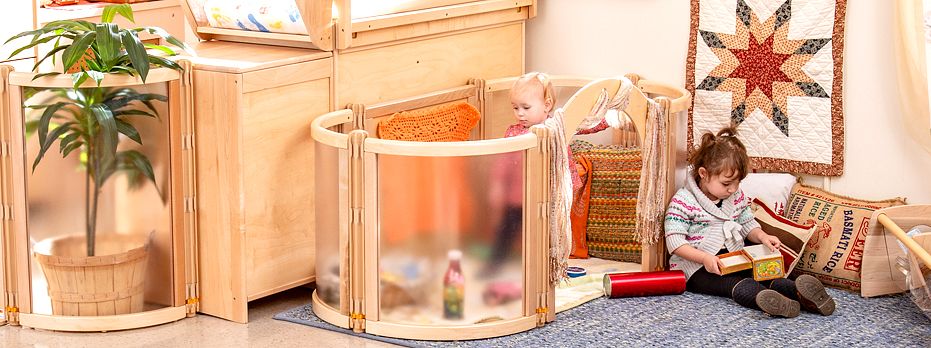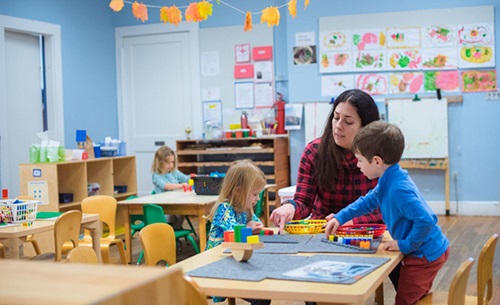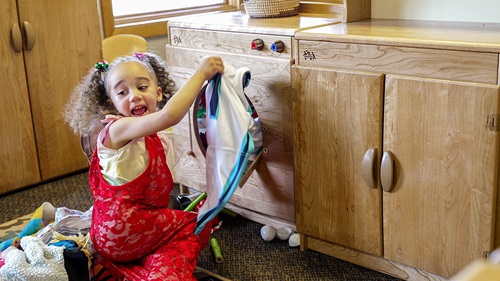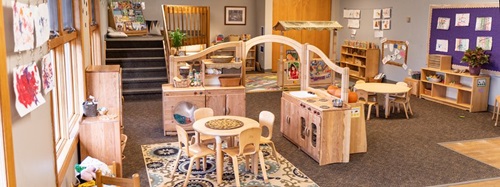Creating Cozy, Comfy, and Cuddly Childcare
| September 2008The spaces for young children in childcare need to be carefully planned based on an understanding of early care and education as well as architecture. Adults need to think about what messages the environmental space gives the children. Often areas that are “academic” are thought about, but soft spaces are thrown together with little planning. When there are plenty of play spaces, they may be missing essential elements (e.g., a cozy corner). This is a pity, as these spaces can play a key educative role.
As described in The Reggio Emilia Approach (Sussna, 1995), children in childcare have a chance to learn from three Teachers. The three teachers are: the environment, the other children, and their teachers. Properly planned soft places are not only an important part of the environment, but facilitate learning, and thus greatly enhance children's development.
Critical Environmental Needs
Many children spend most of their day in a center each week. Yet, Anita Rui Olds (2000) states that the average center environment provides very few furnishings for relaxation, minimal areas of comfort, and little or no space for a child to be alone.
According to Rui Olds (2000), there are four critical environmental needs in the classroom: 1) movement, 2) comfort, 3) competence, and 4) control.
Movement needs are met when each child can safely move without being too restricted, yet has clear limits.
Comfort results from providing a balance of having neither too much nor too little stimulation.
Competence is achieved by organizing an accessible assortment of activities in a variety of places; this allows each child to find the activities they enjoy. Too much “stuff,” however, can be overwhelming, and confuses rather than supports independance.
Finally, children have the control they need if quiet areas are available when they need to calm down or adjust to stresses (Sussna, 2002). Rather than the teacher giving a humiliating “time out," the child can control the situation herself. Perhaps a child is working on a journal and it’s too noisy at her table. She may ask to go to the book area to control the stimulation. Providing quiet places will help children find the strategies that work for them to succeed.
Ideas for Soft Spaces
When looking at classrooms in an Early Care and Education setting, one should see soft spaces and quiet corners appropriate for the age of the children. A child should not have to sneak into the bathroom to be alone for a minute. Nor should he or she have to pretend to be sick in order to lie down.
Some of the soft spaces mentioned in Creative Curriculum (2001) are:
- carpeting,
- pillows,
- mattresses covered with appealing fabrics,
- bean bag chairs,
- a lap to sit in to help the children feel calm, and
- a place to be alone.
All About the ECERS-R (2003) reminds adults to look at the condition and accessibility of the soft items. Children can tell if the materials are purely decorative or if they are meant to be cozy. (Once I was rating a classroom—after a teacher had incorporated new soft materials—and a child zestfully asked me, “Did you bring in this stuff!”)
Rui Olds (2000) gets specific when discussing ways to soften childcare environments. As just one example, consider pillows. She suggests a variety of shapes and sizes:
- 12-to 18 inch throw pillows
- 24 inch soft stuffed pillows
- Pillows that double as puppets
- Velour-covered bean bag chairs
- Large stuffed mats
- 24-inch square foam pillows around ½-foot high to serve as occasional seats for adults and children. They can also serve as materials for building or impromptu castles and places to be alone.
There are many other soft items that may be added to the childcare environments. How about couches to snuggle and be read to? I have also seen couches work well in transition areas for parents to spend time as a child comes to class or says goodbye. Even in the block area, make a place to lie down with a clipboard and write a sign. As you brainstorm with other educators, you will come up with many more ideas.
Health and safety is, of course, the number one concern. Soft items need to be clean.
Nothing should look as if it has been used as a tissue by sneezing children. In fact, it’s a good idea to make sure there’s a way to wash soft surfaces (especially in the infant and toddler rooms). Pillow and mattress covers should be removable so they may be put in a washing machine.
Soft Stuffed Animals
Children love stuffed animals to snuggle up with in the reading area. You can easily get stuffed animals to go with many of the children’s favorite books, which may help to enhance a child’s imagination. Watch a child’s face light up when he gets to play with a character that goes with a favorite book. Introduce the children to Brown Bear and Hungry Caterpillar stuffed animals when they are looking at these books by Eric Carle, or to Max when you are reading Maurice Sendaks’s Where the Wild Things Are for the fifth time.
At many childcare centers, children nap. Isn’t it homier with a few animals to wrap your arms around? They also give some children power and help them have a sense of control.
Dolls and animals to take care of and cuddle with in the pretend area are enjoyed by most children. When it’s a veterinarians’ office, it makes sense to have a variety of animals (such as rabbits, dogs, and cats).Cuddly soft animals are comforting and help children stretch their imaginations.
Safety in Private Places or Hidden Nooks
When creating cozy areas, it may be tempting to arrange for a “hidden nook.” One has to be careful about this, however. Eleanor Reynolds (2006) addresses caregiver's concerns for making sure children can be seen. Caregivers do not want even a moment when a child can hide behind lots of soft items (or anything else). She provides helpful keys for educators dealing with this issue. Childcare environments should always provide for the greatest number of children’s choices and for independence. You want a vibrant, but safe and supervised environment.
The key to safety is being there: It is optimal in early care environments to have two adults working with the children. These adults should arrange to take on their role for the day (or week). One adult will be the quintessential supervisor. The other teacher (“the floater”) can also supervise, but may have other jobs as well.
The supervisor for the day must not stray, even for a moment, from the important job of remaining with the children at all times (both physically and mentally). This teacher’s job is to stay alert and focused on the whole group. It is essential to avoid personal conversations with parents (ask them to save conversations) and other teachers while you’re supervising.
Being there also includes:
Positioning – Put yourself in position: Stand, kneel, squat or sit where you can see all children at all times. If an area can’t be seen, get rid of it.
Circulating – Move around the area, making eye contact with kids, reinforcing desirable behavior and dealing with any problems that arise.
Conclusion
On a visit to the Bing School at Stanford University, a graduate researcher pointed out why this was such an enjoyable environment for children: the architects had knelt down to the children’s level to check out what was functional and pleasing from that perspective (Sussna, 1997). Try it in your room. Get on the floor and make yourself the size of the children using the space. Look at the soft areas and private spaces. Count these, as well as pillows, stuffed animals, and dolls. If the room is lacking something in this area, brainstorm solutions. Dare to take some small actions to add and improve your childcare environment. I can't sew, but I had parents that changed one toddler room from cold to homey and it was a win-win solution. Everyone felt ownership. The children were so proud when they brought in the new, soft, materials.






